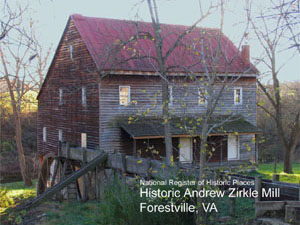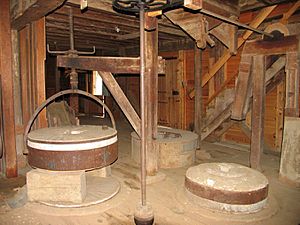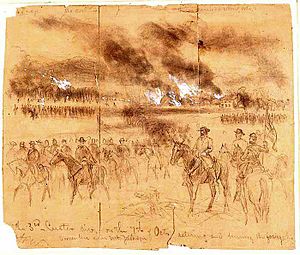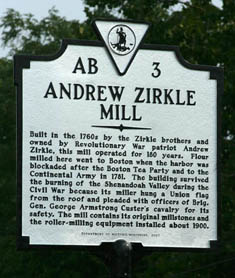Zirkle Mill facts for kids
|
Zirkle Mill
|
|

Historic Andrew Zirkle Mill in Forestville, VA.
Circa 1760 |
|
| Nearest city | Quicksburg, Virginia |
|---|---|
| Area | 2.2 acres (0.89 ha) |
| Built | 1760 est. |
| Architect | Zirkle Brothers |
| NRHP reference No. | 83003316 |
Quick facts for kids Significant dates |
|
| Added to NRHP | February 10, 1983 |
The Andrew Zirkle Mill is an old grist mill built around 1760 in Shenandoah County, Virginia. A grist mill is a place where grain, like wheat or corn, is ground into flour. This mill was added to the National Register of Historic Places in 1983. It's a great example of how mills and factories were built a long time ago.
Contents
A Special Virginia Landmark
This mill was built by German pioneers. These early settlers moved to the area from Pennsylvania in the 1750s. The Zirkle Mill shows us how hardworking and smart these first settlers were. It's an important piece of early frontier life. Because of its history and how it was built, it was added to the Virginia Historic Landmark Registry in 1982.
How the Zirkle Mill Was Built
In 1749, a man named Thomas Lord Fairfax gave a large piece of land, about 224 acres, to George Brock. Brock later sold this land in 1757 to [Andrew Zirkle]. Andrew came to the area in 1755 with his four brothers, two sisters, and his mother. Soon after, Andrew and his brothers built the mill.
We don't know the exact year the mill was finished. But we do know it was working by 1781. Many stories say it was built in the early 1760s.
The mill has a strong log frame. It uses a special building method called mortice and tenon construction. This means pieces of wood fit together like puzzle pieces. The main beams are huge, about 40 feet long and over a foot thick! The mill sits on a strong foundation made of stone, built right into the hillside. Part of the foundation rests on solid limestone rock. There's also a natural crack in the rocks where the waterwheel is.
How the Mill Works
The waterwheel gets its power from a mill race. This is a channel that carries water from Holman's Creek, nearly half a mile upstream. As the water gets close to the mill, it flows into a raised wooden flume. This flume guides the water to the large Fitz Waterwheel. The waterwheel is 20 and a half feet tall and 2 feet wide! It was made by the Fitz Waterwheel company in Hanover, PA and put in place in 1921.
Inside the mill, you can see many old machines. The original granite and French quartz millstones are still there. These stones were used to grind grain. There are also roller milling machines that were added around 1900. You can also find sifters and bolters, which are machines that separate the flour from other parts of the grain. In the basement, there's a special Fitz gearing system. This system takes the power from the waterwheel and makes all the other machines work.
The Mill's Long History
The Zirkle Mill has a rich history, including its role during important times in America.
Helping During the American Revolution
During the American Revolution, after the Boston Tea Party, the British closed Boston Harbor. This made it hard for people in Boston to get food. The historian George Bancroft wrote that people from the Northern Shenandoah Valley sent flour to help. It's a family story that the Zirkle Mill was one of the places that provided this flour. We know for sure that in 1781, Andrew Zirkle gave six barrels of flour to the Continental Army.
A Road to the Mill
In 1784, people living nearby asked to build a road from the mill east to New Market. Andrew Zirkle and his brother Michael signed this request. The court records show that Michael and Andrew Zirkle were asked to find the best path for a road from the mill to a blacksmith shop.
Changing Owners
In 1817, Andrew Zirkle asked that the mill be sold after he passed away. It was sold to George Mowrey, who worked at the mill. But Mowrey couldn't keep it, and it changed hands many times. In 1853, Peter Myers bought the mill.
The Civil War and a Clever Trick
The American Civil War brought fighting to the Shenandoah Valley. After a battle, Union General Phillip Sheridan was ordered to burn farms and mills. This was to stop the Confederate army from getting food. As Union troops moved through the valley, they set many buildings on fire.
At the Zirkle Mill, the miller, Samuel Hockman, saw other mills burning. He quickly grabbed a Union Flag (the flag of the United States at the time). He climbed onto the mill's roof and hung the flag there. Then he ran to meet the Union Cavalry officers. The flag and his pleas convinced them to spare the mill. It was the only mill on Holman's Creek that survived that day! The Union General in charge of the cavalry there was George Armstrong Custer. This amazing story is told in a book called "The Burning: Sheridan in the Shenandoah Valley."
After the war, some local people thought Hockman was on the Union side. They stopped using the mill. So, the owner, Peter Myers, had to sell it. Joseph Andrick bought the mill in 1867. His sons, Casper and Charles, later ran the mill. They made it better by adding roller milling equipment, much of which is still there today.
The mill changed owners several more times. In the late 1940s, it finally stopped working after 180 years. It couldn't compete with newer, bigger factories.
Saving the Mill
The mill was left alone for many years. Then, in 1980, a carpenter named Glen Hofecker bought it. He worked hard to fix it up. During his ownership, the mill was added to the Virginia Historic Landmark Register in 1992 and the National Register of Historic Places in 1993.
Hofecker sold the mill in 1992 to Bowman Fruit Sales, a company owned by Gordon D. "Sonny" Bowman. After 11 years, Bowman Fruit Sales decided to sell the mill. The Frontier Culture Museum in Staunton, Virginia became interested. They wanted to move the top part of the mill to their museum.
Two people related to the Zirkle family, Rob Andrews and Sherryl Andrews Belinsky, started a group called the Save the Zirkle Mill Foundation. They worked for a year to keep the mill where it was. In 2005, the Governor of Virginia, Mark Warner, said the museum could not buy the mill.
A few months later, the mill was for sale again. Andrews and Belinsky made an offer, and on January 5, 2006, they became the new owners of the Andrew Zirkle Mill!
A New Chapter for the Mill
The new owners are working to bring the mill back to life. It will take many years, but they have big plans. They have already added signs to the property. Recently, a historic highway marker was put in the parking lot across from the mill. This marker was given by the Virginia Society of the Sons of the American Revolution.
They are also making improvements to the area around the mill. Part of the land is now used for farming again. For safety reasons and because they want to make changes carefully, the mill is currently closed to visitors.






